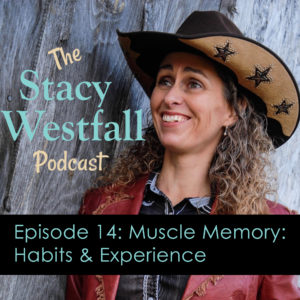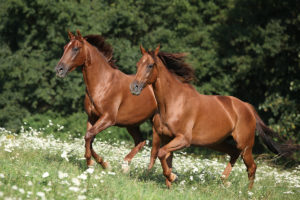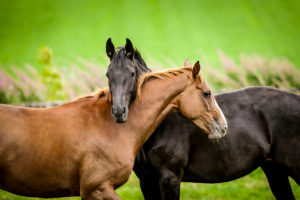Episode 14: Muscle Memory: habits & experience can improve your horseback riding skills

This week we are talking about muscle memory. I’m going to share my two different views on muscle memory and one way that you can fast-forward you’re learning. Last week, I talked about muscle memory being different than your strength or fitness level.
I think people get confused about these concepts because in the beginning, they both come together. When you are learning to ride a horse, you develop new muscles and new skills. In this episode, I am focusing on the muscle memory side of learning to ride.
“Repetition helps when you're trying to learn how to refine, hone, or sharpen a skill.” Stacy Westfall Click To TweetSubscribe and never miss an episode! (I listen in the barn and when I’m out driving)
Subscribe For Free!
Show Notes
[01:28] Muscle memory is a type of habit. An example of this would be when we learn to write.
[02:23] Repetition and putting enough time into riding is what’s needed to form this type of muscle memory.
[03:01] You need to put in the time and the repetitions in order to create a feedback loop. Once you create a feedback loop, then you have something that you can modify.

[03:38] Repetition helps when you’re trying to learn how to refine, hone, or sharpen a skill.
[04:07] A lot of riders are uncomfortable with asking the horses for a lot of repetition.
[06:26] Time plus repetition will create a feedback loop that you can modify.
[06:52] Experience muscle memory (where you feel something) is important because it will enable you to fast forward your learning with horses.

[08:10] Riding well trained horses can help with this.
[09:17] By riding a well-trained horse, you get a longer opportunity to feel the muscle memory when a horse does a maneuver correctly.
[10:36] When you know what it feels like in your body, you will better be able to reward a green horse when they do a correct maneuver briefly.
[10:49] I would be willing to pay more for a lesson on a well-trained horse.
[11:37] Training on a well-trained horse will help you have the awareness in your body to fast forward the training of your own personal horses.

[11:46] Embrace the idea of repetition.
[12:28] If you are taking lessons, ask to take a lesson on a well-trained horse.
[12:49] Just one lesson on a well-trained horse can put some really cool feelings into your body that will make it easier for you to translate that and transfer it over to your own horse.
“Training on a well-trained horse will help you have the awareness in your body to fast forward the training of your own personal horses.” Stacy Westfall Click To TweetLinks and Resources:
8 Comments
Leave a Comment
SUBSCRIBE TO THE PODCAST HERE:





YOURS FREE
WHY IS MY HORSE...?





Never thought of this option but it is something that has been bugging me. Am I doing it right? I have never had a gaited horse until now, and rode one only once 30 years ago. I guess I had better start looking. Thank you!
One of the skills I teach at school is typing. That is also a good example of muscle memory and the use of repetition. I agree with you on repetition. I get those same thoughts sometimes–“my horse doesn’t like it” especially at the lope. When I lope the first time she does really well, then we break down to a trot, trot a little bit and then lope again. What I notice is that sometimes her ears are pinned when I ask for the lope–what does that mean? Does it mean, she is mad, she doesn’t want to do it—so I cannot wait to hear your podcasts about the horses mind. I also notice she speeds up the more I lope her. For instance, when I ask for the lope the first time she usually takes off fairly nice, later when I ask again, she leaps into the lope, like she is mad about it. Why does she do that? Why does she lope nice the first time and then the second, third, and fourth time she is cranky about it. It is not like I lope her for a long time–maybe 3 circles or a straight line. Sometimes I think– is she not in shape enough and she gets sloppy. Is that even something that happens? I love the idea of riding on an experienced horse. That is a great idea. As with you, I love doing different things with my horse. It is a lot of fun mixing things up. I also believe it is good for the horse as well.
Have you used the second-hand slide much in the lope? (the rein technique not the bad line dance reference:)
Yes, it can be from lack of muscle tone for the lope. The more collected lope requires more strength and balance. You can work on building her strength at the lope both from her back and from the ground. I’m currently working on Prestos strength and I should be able to string together some videos showing how he was when he was weaker vs stronger. He started out loping 8-10 laps on the line and now lopes 20 easily.
Have you added many trot logs either lunging or riding?
You can also add them to the lunge line canter too. I know you have some questions about small jumps and lunging over ground poles at the trot (space about 4 feet or a bit less) and even one log at opposite sides of your lope circle when lunging will help.
Yes Stacy I have tried the second had slide at the lope. At the trot, she gets it–when I squeeze and slide my hand down she knows to slow down—at the lope not getting it as much. She breaks down to a trot. I need to find that balance of squeezing and pulling back. My question at this point is would you ask for the lope again when she goes down to a trot and try the process again?
I have not done logs however I am going to work more on the lunge line at the canter and trot to build her strength back up. I need to do more of that—I do not do it enough. Definitely have spring fever–time changes next week
Thanks for your response!
I would focus on building her up on the lunge line and see what kind of feedback you get from her. Notice how quickly she gets out of breath (count laps) and also see how quickly the quality of her lope changes. For example, Presto would start breaking gait as he got tired but over time he has become stronger and has more ‘lift’ in the front end. Basically, it looks easier now.
By starting on the ground you will not wonder how you could be influencing the outcome with your riding aids.
Let me know how it goes!
Thanks for all of your responses. You are really helping me a lot. Hopefully the weather will start cooperating. Spring training will be starting very soon 🙂 I will keep you posted on how it is going.
Wow! It honestly did not occur to me to take a lesson on another horse since I have my own (who is definitely NOT well-trained!).
Thanks again for another thought-provoking and action-provoking podcast!
Let me know how it goes! Riding a different horse ESPECIALLY if you own only one can be really interesting. It is amazing how a horse/rider team can learn to compensate for each other’s imbalances. When this happens it has taken time to develop and doesn’t feel unbalanced. BUT when the rider gets on another horse they often notice it doesn’t feel ‘right’. I’ve switched riders on to multiple horses before until they realized ‘wait…it’s me!’
Trainers are switching horses all the time so they become aware faster. If they see that all the horses they are riding have the same issue they can often figure out the role they are playing in it, as they are the common denominator.
Thanks for listening and for writing!